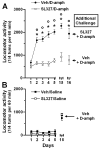Role of the ERK pathway in psychostimulant-induced locomotor sensitization
- PMID: 16512905
- PMCID: PMC1420315
- DOI: 10.1186/1471-2202-7-20
Role of the ERK pathway in psychostimulant-induced locomotor sensitization
Abstract
Background: Repeated exposure to psychostimulants results in a progressive and long-lasting facilitation of the locomotor response that is thought to have implications for addiction. Psychostimulants and other drugs of abuse activate in specific brain areas extracellular signal-regulated kinase (ERK), an essential component of a signaling pathway involved in synaptic plasticity and long-term effects of drugs of abuse. Here we have investigated the role of ERK activation in the behavioral sensitization induced by repeated administration of psychostimulants in mice, using SL327, a brain-penetrating selective inhibitor of MAP-kinase/ERK kinase (MEK), the enzyme that selectively activates ERK.
Results: A dose of SL327 (30 mg/kg) that reduced the number of activated ERK-positive neurons by 62 to 89% in various brain areas, had virtually no effect on the spontaneous locomotor activity or the acute hyperlocomotion induced by cocaine or D-amphetamine. Pre-treatment with SL327 (30 mg/kg) prior to each drug administration prevented the locomotor sensitization induced by repeated injections of D-amphetamine or cocaine. The SL327 pre-treatment abolished also conditioned locomotor response of mice placed in the context previously paired with cocaine or D-amphetamine. In contrast, SL327 did not alter the expression of sensitized response to D-amphetamine or cocaine.
Conclusion: Altogether these results show that ERK has a minor contribution to the acute locomotor effects of psychostimulants or to the expression of sensitized responses, whereas it is crucial for the acquisition of locomotor sensitization and psychostimulant-conditioned locomotor response. This study supports the important role of the ERK pathway in long-lasting behavioral alterations induced by drugs of abuse.
Figures





Similar articles
-
Quantitative changes in Galphaolf protein levels, but not D1 receptor, alter specifically acute responses to psychostimulants.Neuropsychopharmacology. 2007 May;32(5):1109-21. doi: 10.1038/sj.npp.1301230. Epub 2006 Oct 25. Neuropsychopharmacology. 2007. PMID: 17063155
-
Inhibition of ERK pathway or protein synthesis during reexposure to drugs of abuse erases previously learned place preference.Proc Natl Acad Sci U S A. 2006 Feb 21;103(8):2932-7. doi: 10.1073/pnas.0511030103. Epub 2006 Feb 10. Proc Natl Acad Sci U S A. 2006. PMID: 16473939 Free PMC article.
-
Role of cannabinoid type 1 receptors in locomotor activity and striatal signaling in response to psychostimulants.J Neurosci. 2007 Jun 27;27(26):6937-47. doi: 10.1523/JNEUROSCI.3936-06.2007. J Neurosci. 2007. PMID: 17596442 Free PMC article.
-
Time acts as a conditioned stimulus to control behavioral sensitization to amphetamine in rats.Neuroscience. 2000;101(1):1-3. doi: 10.1016/s0306-4522(00)00401-2. Neuroscience. 2000. PMID: 11068130 Review.
-
Drug-induced alterations in the extracellular signal-regulated kinase (ERK) signalling pathway: implications for reinforcement and reinstatement.Cell Mol Neurobiol. 2008 Feb;28(2):157-72. doi: 10.1007/s10571-007-9240-3. Epub 2007 Nov 28. Cell Mol Neurobiol. 2008. PMID: 18041576 Free PMC article. Review.
Cited by
-
Neuronal scaffolding protein spinophilin is integral for cocaine-induced behavioral sensitization and ERK1/2 activation.Mol Brain. 2019 Feb 25;12(1):15. doi: 10.1186/s13041-019-0434-7. Mol Brain. 2019. PMID: 30803445 Free PMC article.
-
Reciprocal activation/inactivation of ERK in the amygdala and frontal cortex is correlated with the degree of novelty of an open-field environment.Psychopharmacology (Berl). 2016 Mar;233(5):841-50. doi: 10.1007/s00213-015-4163-z. Epub 2015 Dec 19. Psychopharmacology (Berl). 2016. PMID: 26685992
-
A role for calmodulin-stimulated adenylyl cyclases in cocaine sensitization.J Neurosci. 2009 Feb 25;29(8):2393-403. doi: 10.1523/JNEUROSCI.4356-08.2009. J Neurosci. 2009. PMID: 19244515 Free PMC article.
-
Cell-Type-Specific Adaptions in Striatal Medium-Sized Spiny Neurons and Their Roles in Behavioral Responses to Drugs of Abuse.Front Synaptic Neurosci. 2021 Dec 14;13:799274. doi: 10.3389/fnsyn.2021.799274. eCollection 2021. Front Synaptic Neurosci. 2021. PMID: 34970134 Free PMC article. Review.
-
Unraveling the differential functions and regulation of striatal neuron sub-populations in motor control, reward, and motivational processes.Front Behav Neurosci. 2011 Jul 28;5:47. doi: 10.3389/fnbeh.2011.00047. eCollection 2011. Front Behav Neurosci. 2011. PMID: 21847377 Free PMC article.
References
-
- Stewart J, Badiani A. Tolerance and sensitization to the behavioral effects of drugs. Behav Pharmacol. 1993;4:289–312. - PubMed
-
- De Vries TJ, Schoffelmeer AN, Binnekade R, Mulder AH, Vanderschuren LJ. Drug-induced reinstatement of heroin- and cocaine-seeking behaviour following long-term extinction is associated with expression of behavioural sensitization. Eur J Neurosci. 1998;10:3565–3571. doi: 10.1046/j.1460-9568.1998.00368.x. - DOI - PubMed
Publication types
MeSH terms
Substances
LinkOut - more resources
Full Text Sources
Other Literature Sources
Miscellaneous

